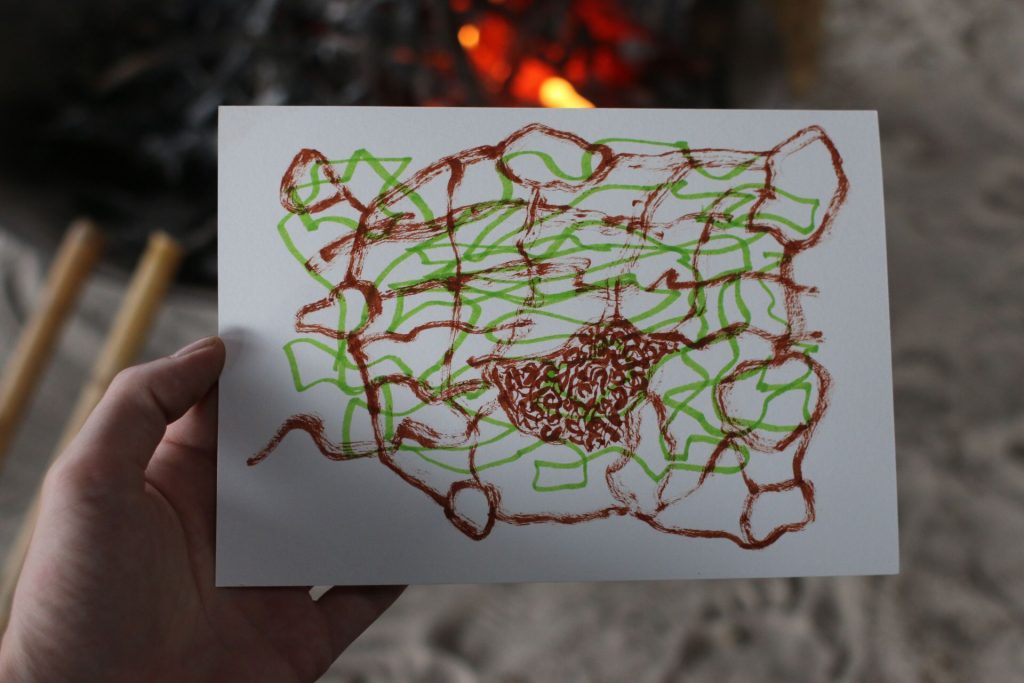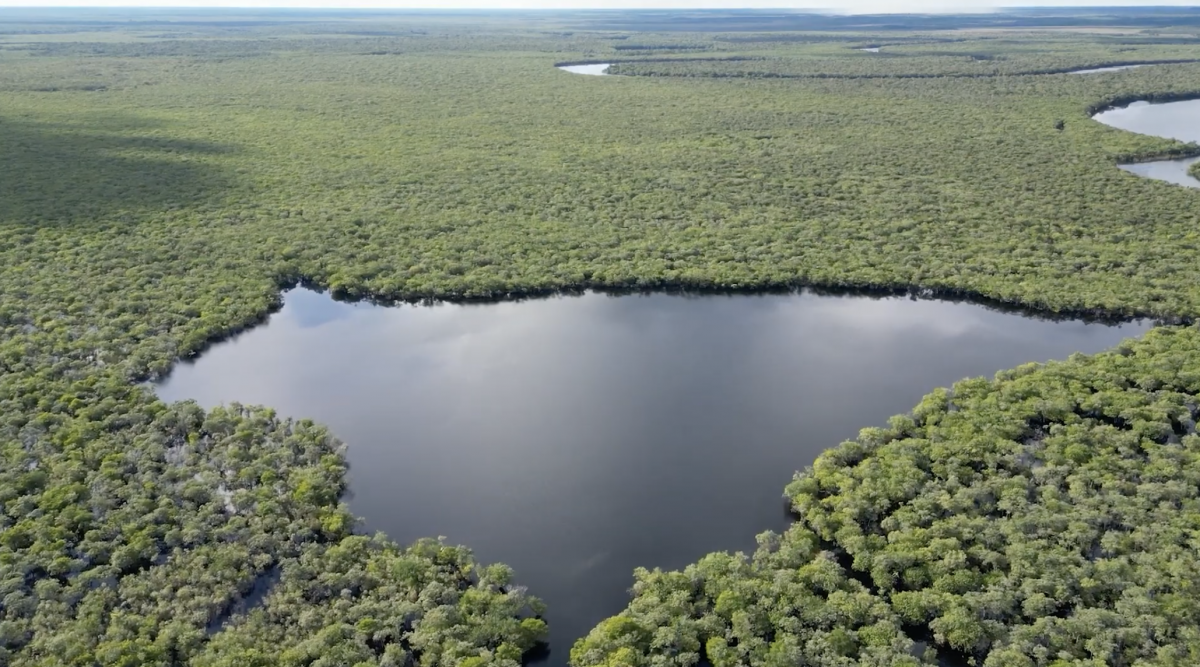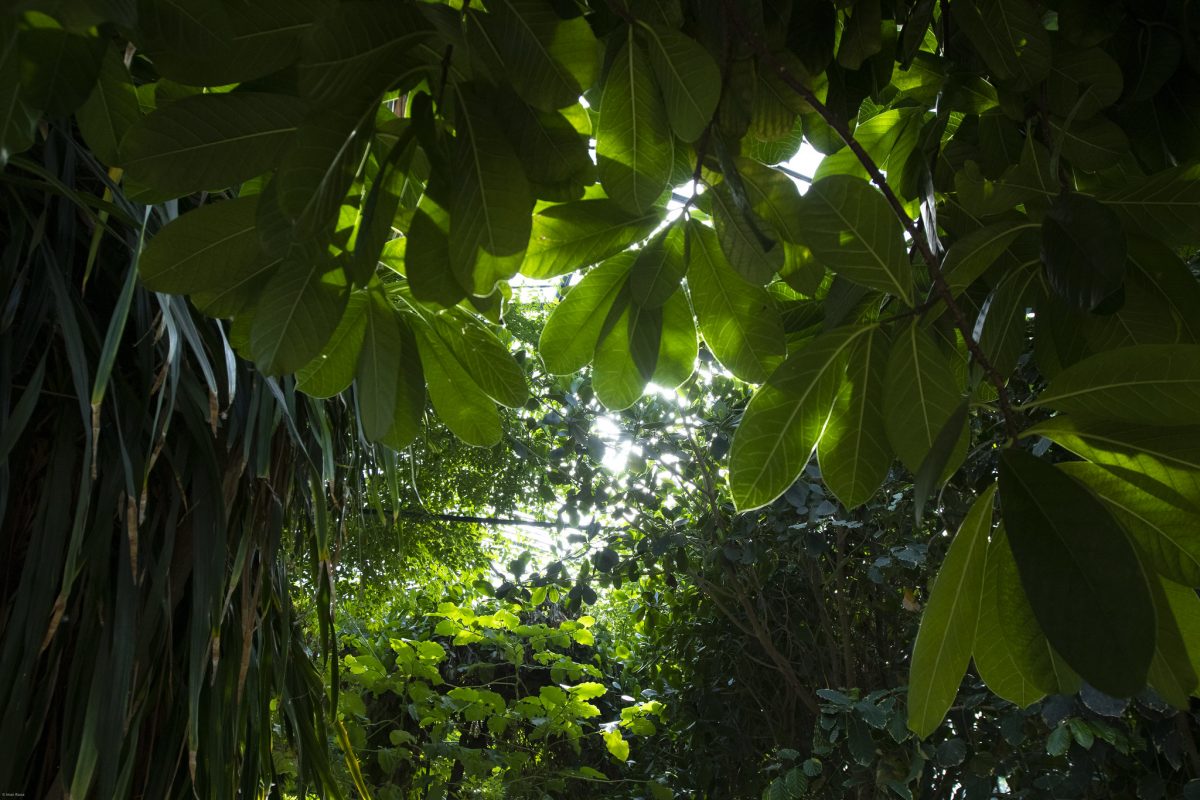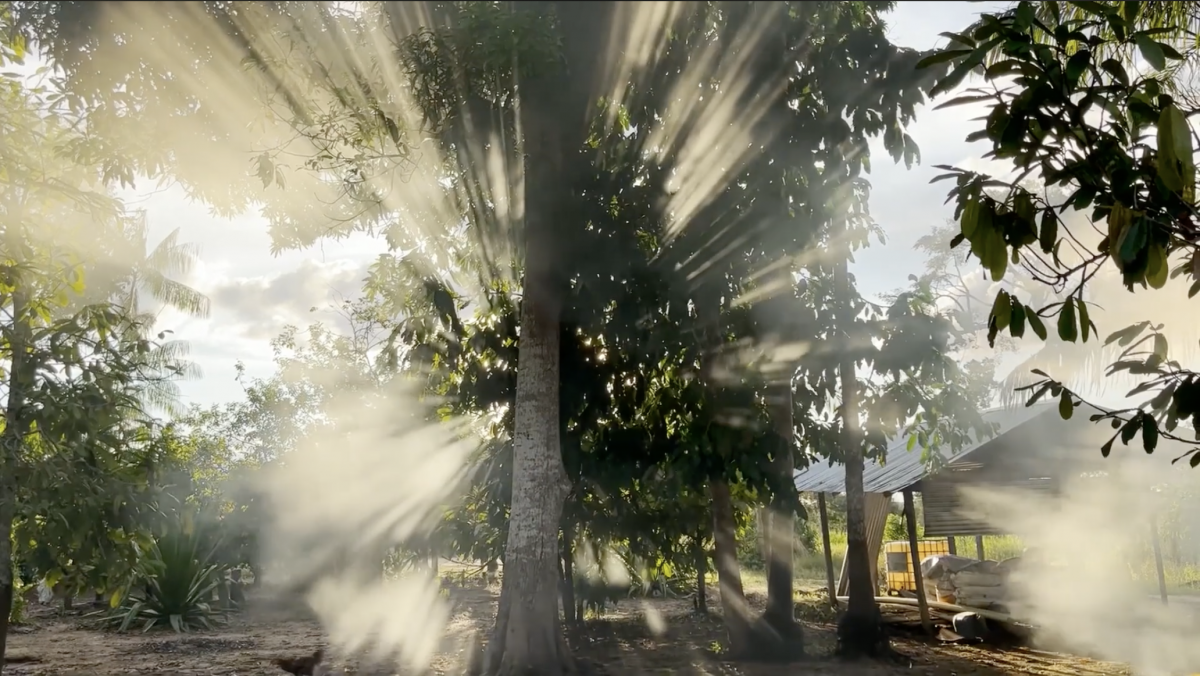Entre fibras y significados (Between fibres and meanings)
Esta es una pequeña recopilación de notas sueltas que contienen reflexiones sobre la experiencia de preparación, inmersión y reflexión alrededor de la residencia Organizmo Bloom en la Comunidad de La Urbana en el río Matavén, en Octubre y Noviembre del 2022.
Esta reflexión es continua y está en pleno proceso silencioso de fermentación. Por tanto comparto estas notas con un llamado a que sean tomadas como una de muchas iteraciones mutables y vivas. Al tratar de poner algunos sentires en palabras quiero aclarar que estos son mis sentires personales, subjetivos, construidos desde la pequeñez de una perspectiva parcial llena de filtros culturales y puntos ciegos.
Desde mi práctica personal de tejido intangible, como anudador de significados y relaciones –como poeta y como oráculo (que es uno y lo mismo), a veces se me dificulta mostrar el detalle de un tejido que no se puede sostener con las manos, pero sin embargo se siente, se vive desde la entraña o a través de las sutileza de compartir aire.
Desde mi estadía en Matavén regreso constantemente a dos áreas de reflexión:
La primera tiene que ver con la fibra, el material con el que se teje.
El territorio determina sus fibras. Hay fibras suaves y acogedoras, y fibras resistentes, fibras duras, fibras maleables. La fibra misma demanda cómo se teje con ella.
El mamure y la piragua son fibras que demandan ser buscadas y reconocidas.
Los bejucos crecen donde los bejucos crecen, no donde los seres humanos los plantan. Los bejucos mismos se tejen a su entorno como estrategia de vida.
Recolectar bejucos implica entender el tejido de su ecosistema, no desde el pensamiento, sino desde el sentir del cuerpo. Jalar un bejuco va mucho más allá de aprender a reconocerlo según taxonomías, implica conocerlo desde la intimidad de su fibra en contacto con el cuerpo de uno, saber de su elasticidad y de la fuerza precisa para desgarrarlo sin romperlo.
Recolectar bejucos como material preciado es un saber del cuerpo. Este conocimiento es a la vez un auto-conocimiento y una relación.
Pensando en el tejido como relación, me resulta urgente entender mi propia fibra y la de los demás. Quiero que nos preguntemos: ¿Tú sabes de qué estás hecho? ¿Sabes qué tipo de tejido demanda tu propio material? ¿Entiendes con todo tu cuerpo, tu ser, qué tipo de proceso necesitas para enlazarte con otras fibras? ¿Conoces las propiedades únicas de la composición de tu fibra? ¿Sabes del cuidado necesario para mantenerla flexible y robusta a la vez? ¿Entiendes qué formas y estructuras te ayudan a expresar los dones de tu fibra y cuáles los debilitan?
El tejido abstracto implica una capacidad para liarse en curiosidades existenciales.
La segunda área de reflexión que me habita es la del tejido que nos sostiene a todos. Me siento torpe tratando de articular el paralelo que siento entre la vida de río y la oralidad.
Entre gentes nos tejemos, en parte, con expresión, y buena parte de esta expresión se da en la vibración del lenguaje oral como un flujo constante.
Parte de la identidad Piaroa es ser dueños de la palabra, y en mi experiencia de los usos de su lenguaje (lenguaje que no entiendo cognitivamente) siento yo un énfasis en saber tejer y reconocer vibración, de la misma manera en que el pescador sabe de las vibraciones distintas que cada tipo de pez hace bajo el agua.
Una de las expresiones más bellas y movilizadoras de la experiencia en Matavén fue el ser testigos del canto-llanto, un diálogo cantado y lleno de emoción. Para mí es un diálogo desde la vibración de la voz en el umbral del sollozo.
Vibrar emoción y vibrar silencio es también un saber del cuerpo. Saber nombrar como acto de respeto implica saber callar. Sospecho que conocer el buen uso de la palabra es como conocer el río. Un conocimiento íntimo de la fibra que lleva la expresión adecuada. A no vibrar en desentono, a saber de la fibra propia y sus potenciales en el baile con los flujos más grandes que nos abarcan.
En el proceso inmersivo de recorrer el Matavén y sus atajos en potrillo (o canoa) tuve una probadita de lo que podría significar saber leer primero desde la vibración y no del símbolo, y de la presencia y atención que demanda desde un lugar de apertura que carece de tensión.
Esta una nota de mi cuaderno después de una salida a remar por el Matavén:
Remar en un río donde no hay corriente es ligero, fluye, no es esfuerzo. Pienso en volar, en flotar. No hay resistencia y el cuerpo no se cansa. El desliz del potrillo sobre el agua me permite ser ave y pez a la vez.
En la sombra de los atajos, entre las ramas y a la altura de las copas de los árboles; los reflejos en el río espejo hacen nidos imposibles, marañas; mitad juego de luz, espejismo; y mitad tejido de bejuco y sombra.
En el placer que confunde y altera mi visión, pierdo mi propia imagen, mi percepción de mí. Por un ratito, soy solo ojo. Mi cuerpo es uno con la balsa que flota.
Resuenan las palabras para interrumpir esa comunión con el resguardo del atajo y la balsa: “Todo vibra”.
Llegó el pensamiento.
Al evocar que todo vibra misterio, he roto mi presencia con él, me he separado del misterio que respiraba.
Aquí unas imágenes que compartí con el grupo de viajantes antes de partir a Matavén, sentados alrededor del fuego dentro del toroide.
Esta es una escultura imaginada:
Me siento a tejer una especie de red. La tejo por días a distintas horas y en distintos lugares. Mientras la tejo evoco e invoco, exorciso, añoro, bendigo –y bueno, maldigo, hay que ser honestos. Cuando me canso de tejer digo: “Esta es solo una red, solo un momento en el tiempo, y la doy por terminada”.
Luego salgo a caminar arrastrando mi red por detrás a ver qué atrapo.
Primero hago un inventario de lo que atrapé dentro de mí: memorias, fantasías, pensamientos, imágenes, deseos.
Y de lo que atrapé fuera de mí: piedritas, bichos, hojarasca, polvo, tierra, plástico, caca, plumas, pelos.
Luego lo ato todo con mucho cuidado. Lo organizo bonito, veo cómo encaja, cómo contrasta. Aquí hay composición y un retorno a la actividad tan humana de abstracción, de manejar conceptos y luego organizarlos, otra actividad que nos ayuda a darle sentido a las cosas.
Esta es una reflexión a partir de una pequeña actividad oracular basada en un dibujo automático. El dibujo está compuesto por líneas contínuas que crean laberintos en tonos verde y marrón. En la parte central, un poco hacia abajo del cartón, hay un área concentrada en plumón marrón donde las líneas se aprietan entre sí, anudándose de una manera más densa.
Siempre hay un meollo del asunto donde todo parece más complejo, más denso, entreverado, liado. Las conexiones son más estrechas y hay menos aire, menos espacio. Pero ese atadito denso, ese meollito, está conectado con otros núcleos.
Y detrás, pero también por encima, hay otras redes con sus propios núcleos. A través de distintos planos y dimensiones el saber de que nada sucede en aislamiento.

Between fibres and meanings
This is a small collection of loose notes containing reflections on the experience of preparation, immersion and reflection around the Organizmo Bloom residency in the La Urbana Community on the Matavén River in October and November 2022.
This reflection is ongoing and in a quiet process of fermentation. I therefore share these notes with a call for them to be taken as one of many changing and living iterations. In trying to put some sense into words I want to clarify that these are my personal, subjective reflections, constructed from a partial perspective full of cultural filters and blind spots.
From my personal practice of intangible weaving, as a weaver of meanings and relationships – as a poet and as an oracle (which is one and the same), it is sometimes difficult for me to show the detail of a weaving that cannot be held with my hands, but is nevertheless felt, lived from the core or through the subtlety of sharing breath.
Since my stay in Matavén I constantly return to two areas of reflection:
The first has to do with the fibre, the material with which it is woven.
The territory shapes its threads. There are soft and welcoming fibres, and resistant fibres, hard fibres, malleable fibres. The fibre itself demands how it is woven.
Mamure and piragua are fibres that demand to be sought and recognised.
The vines grow where the vines grow, not where humans plant them. The vines themselves weave themselves into their environment as a living arrangement.
Collecting lianas implies understanding the weaving of their ecosystem, not from thought, but from the feeling of the body. Pulling a liana goes far beyond learning to recognise it according to taxonomy, it implies knowing it from the intimacy of its fibre in contact with one’s body, knowing its elasticity and the precise strength to tear it without breaking it.
Collecting lianas as a precious material is a knowledge of the body. This knowledge is both a self-knowledge and a relational knowledge.
Thinking of weaving as a relationship, it is important for me to understand my own fibre and that of others. I want us to ask ourselves: Do you know what you are made of? Do you know what kind of weaving your body material demands? Do you understand with your whole body, your being, what kind of process you need to link with others? Do you know the unique properties of your fibre’s composition? Do you know the care needed to keep it flexible and robust at the same time? Do you understand which forms and structures help you to manifest the qualities of your fibre and which weaken them?
Abstract weaving implies a capacity to become entangled in existential intricacies.
The second area of reflection that inhabits me is that of the fabric that sustains us all. I feel awkward trying to articulate the parallel I feel between river life and orality.
Among people we weave ourselves, in part, with expression, and much of this expression is given in the vibration of oral language as a constant flow.
Part of the Piaroa identity is to be masters of the word, and in my experience of the uses of their language (language that I do not understand cognitively) I feel an emphasis on knowing how to weave and recognise vibration, in the same way that the fisherman knows the different vibrations that each type of fish makes under the water.
One of the most beautiful and mobilising expressions of the experience in Matavén was witnessing the song-song, a sung dialogue full of emotion. For me it is a dialogue from the vibration of the voice on the threshold of sobbing.
Vibrating emotion and vibrating silence is also a knowledge of the body. Knowing how to speak as an act of respect implies knowing how to be silent. I believe that knowing the good use of the word is like knowing the river. An intimate knowledge of the fibre that carries the right expression. To not vibrate out of tune, to know one’s own fibre and its potentials in the dance with the larger flows that embrace us.
In the immersive process of travelling the Matavén and its shortcuts by colt (or canoe) I had a taste of what it might mean to know how to read first from the vibration and not from the symbol, and of the presence and attention it demands from a place of openness that is without tension.
This is a note from my journal after a paddling trip on the Matavén:
Rowing in a river where there is no current is light, it flows, it is effortless. I think of flying, of floating. There is no resistance and the body does not get tired. The glide of the colt on the water allows me to be bird and fish at the same time.
In the shadow of the trees, between the branches and at the height of the canopy; the reflections in the mirrored river make impossible nests, tangles; half play of light, mirage; and half weaving of vines and shadow.
In the pleasure that confuses and alters my vision, I lose my own image, my perception of myself. For a little while, I am only an eye. My body is one with the floating raft.
In the joy that confuses and alters my vision, I lose my own image, my perception of myself. For a little while, I am only an eye. My body is one with the floating raft.
Words sound to interrupt this communion with the shelter of the trees and the raft: “Everything vibrates”.
The thought arrived.
By evoking that everything vibrates mystery, I have broken my presence with it, I have separated myself from the mystery that breathed.
Here are some images I shared with the group of travellers before leaving for Matavén, sitting around the fire inside the toroid.
This is an imagined sculpture:
I sit and weave a kind of net. I weave it for days at different times and in different places. While I weave it I evoke and invoke, exorcise, yearn, bless – and well, curse, let’s be honest. When I get tired of weaving I say: “This is just a net, just a moment in time, and I call it a day”.
Then I go for a walk dragging my net behind me to see what I catch.
First I make an inventory of what I caught inside me: memories, fantasies, thoughts, images, desires.
And what I’ve caught outside of me: pebbles, bugs, leaves, dust, dirt, plastic, poop, feathers, hair.
Then I tie it all up very carefully. I arrange it nicely, see how it fits, how it contrasts. Here there is composition and a return to the very human activity of abstraction, of handling concepts and then organising them, another activity that helps us to make sense of things.
This is a reflection on a small oracular activity based on an automatic drawing. The drawing is composed of continuous lines that create labyrinths in shades of green and brown. In the central part, a little way down the cardboard, there is an area concentrated in brown down where the lines are squeezed together, knotting in a denser way.
There is always a heart of the matter where everything seems more complex, more dense, intertwined, tangled. The connections are tighter and there is less air, less space. But that dense bundle, that little bundle, is connected to other cores.
And behind, but also above, there are other networks with their own nuclei. Across different planes and dimensions the knowledge that nothing happens in isolation.



